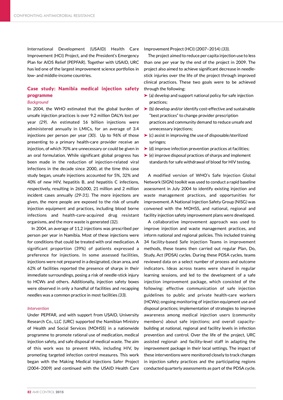
International Development (USAID) Health Care
Improvement (HCI) Project, and the President's Emergency
Plan for AIDS Relief (PEPFAR). Together with USAID, URC
has led one of the largest improvement science portfolios in
low- and middle-income countries.
Case study: Namibia medical injection safety
programme
Background
In 2004, the WHO estimated that the global burden of
unsafe injection practices is over 9.2 million DALYs lost per
year (29). An estimated 16 billion injections were
administered annually in LMICs, for an average of 3.4
injections per person per year (30). Up to 96% of those
presenting to a primary health-care provider receive an
injection, of which 70% are unnecessary or could be given in
an oral formulation. While significant global progress has
been made in the reduction of injection-related viral
infections in the decade since 2000, at the time this case
study began, unsafe injections accounted for 5%, 32% and
40% of new HIV, hepatitis B, and hepatitis C infections,
respectively, resulting in 260,000, 21 million and 2 million
incident cases annually (29-31). The more injections are
given, the more people are exposed to the risk of unsafe
injection equipment and practices, including blood borne
infections and health-care-acquired drug resistant
organisms, and the more waste is generated (32).
In 2004, an average of 11.2 injections was prescribed per
person per year in Namibia. Most of these injections were
for conditions that could be treated with oral medication. A
significant proportion (39%) of patients expressed a
preference for injections. In some assessed facilities,
injections were not prepared in a designated, clean area, and
62% of facilities reported the presence of sharps in their
immediate surroundings, posing a risk of needle-stick injury
to HCWs and others. Additionally, injection safety boxes
were observed in only a handful of facilities and recapping
needles was a common practice in most facilities (33).
Intervention
Under PEPFAR, and with support from USAID, University
Research Co., LLC (URC) supported the Namibian Ministry
of Health and Social Services (MOHSS) in a nationwide
programme to promote rational use of medication, medical
injection safety, and safe disposal of medical waste. The aim
of this work was to prevent HAIs, including HIV, by
promoting targeted infection control measures. This work
began with the Making Medical Injections Safer Project
(2004-2009) and continued with the USAID Health Care
Improvement Project (HCI) (2007-2014) (33).
The project aimed to reduce per capita injection use to less
than one per year by the end of the project in 2009. The
project also aimed to achieve significant decrease in needlestick
injuries over the life of the project through improved
clinical practices. These two goals were to be achieved
through the following:
‰ (a) develop and support national policy for safe injection
practices;
‰ (b) develop and/or identify cost-effective and sustainable
"best practices" to change provider prescription
practices and community demand to reduce unsafe and
unnecessary injections;
‰ (c) assist in improving the use of disposable/sterilized
syringes;
‰ (d) improve infection prevention practices at facilities;
‰ (e) improve disposal practices of sharps and implement
standards for safe withdrawal of blood for HIV testing.
A modified version of WHO's Safe Injection Global
Network (SIGN) toolkit was used to conduct a rapid baseline
assessment in July 2004 to identify existing injection and
waste management practices, and opportunities for
improvement. A National Injection Safety Group (NISG) was
convened with the MOHSS, and national, regional and
facility injection safety improvement plans were developed.
A collaborative improvement approach was used to
improve injection and waste management practices, and
inform national and regional policies. This included training
34 facility-based Safe Injection Teams in improvement
methods, these teams then carried out regular Plan, Do,
Study, Act (PDSA) cycles. During these PDSA cycles, teams
reviewed data on a select number of process and outcome
indicators. Ideas across teams were shared in regular
learning sessions, and led to the development of a safe
injection improvement package, which consisted of the
following: effective communication of safe injection
guidelines to public and private health-care workers
(HCWs); ongoing monitoring of injection equipment use and
disposal practices; implementation of strategies to improve
awareness among medical injection users (community
members) about safe injections; and overall capacitybuilding
at national, regional and facility levels in infection
prevention and control. Over the life of the project, URC
assisted regional- and facility-level staff in adapting the
improvement package in their local settings. The impact of
these interventions were monitored closely to track changes
in injection safety practices and the participating regions
conducted quarterly assessments as part of the PDSA cycle.
CONFRONTING ANTIMICROBIAL RESISTANCE
82 AMR CONTROL 2015